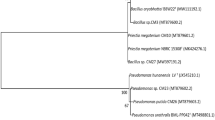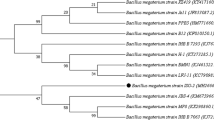Abstract
Microplastics pose significant challenges to ecosystems and organisms. They can be ingested by marine and terrestrial species, leading to potential health risks and ecological disruptions. This study aims to address the urgent need for effective remediation strategies by focusing on the biodegradation of microplastics, specifically polyvinyl chloride (PVC) derivatives, using the bacterial strain Bacillus albus. The study provides a comprehensive background on the accumulation of noxious substances in the environment and the importance of harnessing biodegradation as an eco-friendly method for pollutant elimination. The specific objective is to investigate the enzymatic capabilities of Bacillus albus, particularly the alpha/beta hydrolases (ABH), in degrading microplastics. To achieve this, in-silico studies were conducted, including analysis of the ABH protein sequence and its interaction with potential inhibitors targeting PVC derivatives. Docking scores of − 7.2 kcal/mol were obtained to evaluate the efficacy of the interactions. The study demonstrates the promising bioremediation prospects of Bacillus albus for microplastics, highlighting its potential as a key player in addressing microplastic pollution. The findings underscore the urgent need for further experimental validation and practical implementation of Bacillus albus in environmental remediation strategies.










Similar content being viewed by others
Data availability
All the data has been included in the manuscript.
References
Abada EA, Elbaz RM, Sonbol H, Korany SM (2021) Optimization of cellulase production from Bacillus albus (MN755587) and its involvement in bioethanol production. Pol J Environ Stud 30:2459–2466
Abdel-Shafy HI, Mansour MS (2016) A review on polycyclic aromatic hydrocarbons: source, environmental impact, effect on human health and remediation. Egypt J Pet 25:107–123
Adams GO, Fufeyin PT, Okoro SE, Ehinomen I (2015) Bioremediation, biostimulation and bioaugmention: a review. Int J Environ Bioremediat. Biodegrad. 3:28–39
Altschul SF (2001) BLAST algorithm. e LS
Asiandu AP, Wahyudi A, Sari SW (2021) A review: plastics waste biodegradation using plastics-degrading bacteria. J Environ Treat Tech 9:148–157
Barzkar N, Sohail M, Tamadoni Jahromi S, Gozari M, Poormozaffar S, Nahavandi R, Hafezieh M (2021) Marine bacterial esterases: Emerging biocatalysts for industrial applications. Appl Biochem Biotechnol 193:1187–1214
Cao B, Nagarajan K, Loh K-C (2009) Biodegradation of aromatic compounds: current status and opportunities for biomolecular approaches. Appl Microbiol Biotechnol 85:207–228
Chen X, Li X, Li Y (2021) Toxicity inhibition strategy of microplastics to aquatic organisms through molecular docking, molecular dynamics simulation and molecular modification. Ecotoxicol Environ Saf 226:112870
Conesa A, Götz S, García-Gómez JM, Terol J, Talón M, Robles M (2005) Blast2GO: a universal tool for annotation, visualization and analysis in functional genomics research. Bioinformatics 21:3674–3676
Eltarahony M, El-Fakharany E, Abu-Serie M, ElKady M, Ibrahim AJMCF (2021) Statistical modeling of methylene blue degradation by yeast-bacteria consortium; optimization via agro-industrial waste, immobilization and application in real effluents. Microb Cell Fact 20:1–26
Furukawa K, Suenaga H, Goto M (2004) Biphenyl dioxygenases: functional versatilities and directed evolution. J Bacteriol 186:5189–5196
Gardener M (2012) Beginning R: the statistical programming language. Wiley, Hoboken
Geourjon C, Deleage G (1995) SOPMA: significant improvements in protein secondary structure prediction by consensus prediction from multiple alignments. Bioinformatics 11:681–684
Gogoi M, Bhattacharya P, Sen SK, Mukherjee I, Bhushan S, Chaudhuri SR (2021) Aquaculture effluent treatment with ammonia remover Bacillus albus (ASSF01). J Environ Chem Eng 9:105697
Gu Z, Eils R, Schlesner M, Ishaque N (2018) EnrichedHeatmap: an R/Bioconductor package for comprehensive visualization of genomic signal associations. BMC Genomics 19:1–7
Gupta S, Kapoor P, Chaudhary K, Gautam A, Kumar R, O.S.D.D. Consortium, Raghava GP (2013) In silico approach for predicting toxicity of peptides and proteins. PLoS ONE 8:e73957
Hadian-Ghazvini S, Hooriabad Saboor F, Safaee Ardekani L (2022) Bioremediation techniques for microplastics removal. In: Microplastics pollution in aquatic media: occurrence, detection, and removal. Springer, pp 327–377
Halden R (2010) Plastics and public health. Annu Rev Pub Health 31:179–194
Hale RC, Seeley ME, La Guardia MJ, Mai L, Zeng EY (2020) A global perspective on microplastics. J Geophys Res 125:e2018JC014719
Hopewell J, Dvorak R, Kosior E (2009) Plastics recycling: challenges and opportunities. Philos Trans R Soc B 364:2115
Kamburov A, Herwig R (2022) ConsensusPathDB 2022: molecular interactions update as a resource for network biology. Nucleic Acids Res 50:D587–D595
Kersey PJ, Lawson D, Birney E, Derwent PS, Haimel M, Herrero J, Keenan S, Kerhornou A, Koscielny G, Kähäri A (2010) Ensembl genomes: extending Ensembl across the taxonomic space. Nucleic Acids Res 38:D563–D569
Kiefer F, Arnold K, Künzli M, Bordoli L, Schwede T (2009) The SWISS-MODEL Repository and associated resources. Nucleic Acids Res 37:D387–D392
Kim S, Thiessen PA, Bolton EE, Chen J, Fu G, Gindulyte A, Han L, He J, He S, Shoemaker BA (2016) PubChem substance and compound databases. Nucleic Acids Res 44:D1202–D1213
Kishor R, Saratale GD, Saratale RG, Ferreira LFR, Bilal M, Iqbal HM, Bharagava RN (2021) Efficient degradation and detoxification of methylene blue dye by a newly isolated ligninolytic enzyme producing bacterium Bacillus albus MW407057. Colloids Surf B 206:111947
Kumar S, Stecher G, Li M, Knyaz C, Tamura K (2018) MEGA X: molecular evolutionary genetics analysis across computing platforms. Mol Biol Evol 35:1547
Kumar V, Agrawal S, Shahi SK, Motghare A, Singh S, Ramamurthy PC (2022) Bioremediation potential of newly isolated Bacillus albus strain VKDS9 for decolourization and detoxification of biomethanated distillery effluent and its metabolites characterization for environmental sustainability. Environ Technol Innov 26:102260
Laskowski R, MacArthur M, Thornton J (2006) PROCHECK: validation of protein-structure coordinates
Ledermann B (2018) From metagenomes to green algae—the biochemical variety of bilin biosynthesis enzymes. Dissertation, Kaiserslautern, Technische Universität Kaiserslautern
Lee HM, Kim HR, Jeon E, Yu HC, Lee S, Li J, Kim D-HJM (2020) Evaluation of the biodegradation efficiency of four various types of plastics by Pseudomonas aeruginosa isolated from the gut extract of superworms. Microorganisms 8:1341
Loenarz C, Schofield CJ (2008) Expanding chemical biology of 2-oxoglutarate oxygenases. Nat Chem Biol 4:152–156
McGuffin LJ, Bryson K, Jones DT (2000) The PSIPRED protein structure prediction server. Bioinformatics 16:404–405
Mindrebo JT, Nartey CM, Seto Y, Burkart MD, Noel JP (2016) Unveiling the functional diversity of the alpha/beta hydrolase superfamily in the plant kingdom. Curr Opin Struct Biol 41:233–246
Naveed M, Mubeen S, Ahmed I, Khalid N, Suleria HAR, Bano A, Mumtaz AS (2014) Identification and characterization of rhizospheric microbial diversity by 16S ribosomal RNA gene sequencing. Braz J Microbiol 45:985–993
Naveed M, Shabbir MA, Aziz T, Saleem A, Naveed R, Khan AA, Ul Haq T, Alharbi M, Alshammari A, Alasmari AF (2023) In silico explorations of bacterial mercuric reductase as an ecofriendly bioremediator for noxious mercuric intoxications. Acta Biochim Pol 70(3):661–669
Okal EJ, Heng G, Magige EA, Khan S, Wu S, Ge Z, Zhang T, Mortimer PE, Xu J (2023) Insights into the mechanisms involved in the fungal degradation of plastics. Ecotoxicol Environ Saf 262:115202
Pieper DH (2005) Aerobic degradation of polychlorinated biphenyls. Appl Microbiol Biotechnol 67:170–191
Ramdass AC, Rampersad SN (2022) Detection and diversity of the mannosylerythritol lipid (MEL) gene cluster and lipase A and B genes of Moesziomyces antarcticus isolated from terrestrial sites chronically contaminated with crude oil in Trinidad. BMC Microbiol 22:1–27
Ren L, Lin Z, Liu H, Hu H (2018) Bacteria-mediated phthalic acid esters degradation and related molecular mechanisms. Appl Microbiol Biotechnol 102:1085–1096
Saha J, Adhikary S, Pal AJGJ (2022) Analyses of the heavy metal resistance pattern and biosorption potential of an indigenous Bacillus tropicus strain isolated from arable soil. Geomicrobiol J 39:891–905
Silva GC, Galleguillos Madrid FM, Hernández D, Pincheira G, Peralta AK, Urrestarazu Gavilán M, Vergara-Carmona V, Fuentes-Peñailillo FJA (2021) Microplastics and their effect in horticultural crops: food safety and plant stress. Agronomy 11:1528
Smoot ME, Ono K, Ruscheinski J, Wang P-L, Ideker T (2011) Cytoscape 2.8: new features for data integration and network visualization. Bioinformatics 27:431–432
Studio D (2008) Discovery studio. Accelrys [2.1]
Tokiwa Y, Calabia BP, Ugwu CU, Aiba S (2009) Biodegradability of plastics. Int J Mol Sci 10:3722–3742
Vázquez-Alcántara L, Oliart-Ros RM, García-Bórquez A, Peña-Montes C (2021) Expression of a cutinase of Moniliophthora roreri with polyester and PET-plastic residues degradation activity. Microbiol Spectr 9:e00976-e1921
Verma P, Rawat S (2021) Rhizoremediation of heavy metal-and xenobiotic-contaminated soil: an eco-friendly approach. In: Shah MP (ed) Removal of emerging contaminants through microbial processes. Springer, Singapore, pp 95–113
Wang Y, Boulic M, Phipps R, Plagmann M, Cunningham C, Guyot G (2023) https://www.sciencedirect.com/science/article/pii/S2352710223009816?CMX_ID=&SIS_ID=&dgcid=STMJ_AUTH_SERV_PUBLISHED&utm_acid=229490816&utm_campaign=STMJ_AUTH_SERV_PUBLISHED&utm_in=DM368176&utm_medium=email&utm_source=AC_
Yan Y, Tao H, He J, Huang S-Y (2020) The HDOCK server for integrated protein–protein docking. Nat Protoc 15:1829–1852
Zameer M, Tahir U, Khalid S, Zahra N, Sarwar A, Aziz T, Saidal A, Alhomrani M, Alamri AS, Dablool AS, Sameeh MY, Mohamed AA, Alharbi A (2023) Isolation and characterization of indigenous bacterial assemblage for biodegradation of persistent herbicides in the soil. Acta Biochim Pol 70(2):325–334
Acknowledgements
Authors are thankful to the Researchers Supporting Project number (RSP2024R462), King Saud University, Riyadh, Saudi Arabia.
Funding
No funding was received.
Author information
Authors and Affiliations
Contributions
Conceptualization, MN and TA; methodology, RN and AA; software, MA; validation, MW; formal analysis, MAlharbi; investigation, AFA; resources, AA.; data curation, MA.; writing—original draft preparation, RN and AA.; writing—review and editing, THA; visualization, MN; supervision, MN and TA.; project administration, MN and TA; funding acquisition, MN and TA.
Corresponding authors
Ethics declarations
Conflict of interest
The authors declare no conflict of interest.
Ethical approval
Not applicable.
Additional information
Publisher's Note
Springer Nature remains neutral with regard to jurisdictional claims in published maps and institutional affiliations.
Supplementary Information
Below is the link to the electronic supplementary material.
Rights and permissions
Springer Nature or its licensor (e.g. a society or other partner) holds exclusive rights to this article under a publishing agreement with the author(s) or other rightsholder(s); author self-archiving of the accepted manuscript version of this article is solely governed by the terms of such publishing agreement and applicable law.
About this article
Cite this article
Naveed, M., Naveed, R., Aziz, T. et al. Biodegradation of PVCs through in-vitro identification of Bacillus albus and computational pathway analysis of ABH enzyme. Biodegradation (2024). https://doi.org/10.1007/s10532-023-10064-z
Received:
Accepted:
Published:
DOI: https://doi.org/10.1007/s10532-023-10064-z




